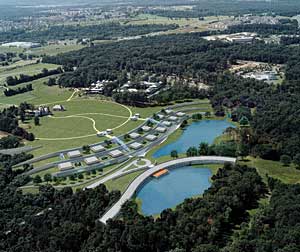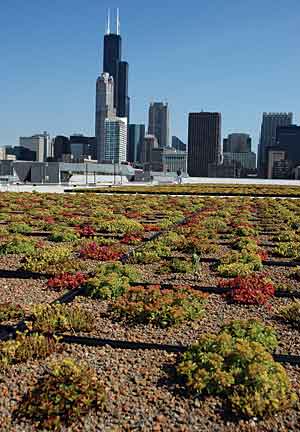Rooftops Slowly, but Steadily, Start to Sprout
 |
| Howard Hughes Medical
Institute Research Campus Slated to open in September, the Howard Hughes Medical Institute is building a research facility covered by a 180,000-square-foot green roof in Loudoun County, Virginia (left). Clusters of offices and conference rooms form the edges of curved and planted terraces. Support spaces not requiring natural light, such as the central plant and parking garage, are located away from the terrace edges. Rendering: © Rafael Viñoly Architects |
Not surprisingly, Chicago has an aggressive set of programs aimed at increasing implementation of green roofs and other sustainable building practices. Since planting of a 20,300-square-foot green roof on city hall in 2000, Chicago has instituted an incentive in the form of a density bonus for building owners that install green roofs. It also requires green roofs on construction projects that receive public assistance or are subject to review by the department of planning. Earlier this summer, the city council approved a plan to offer matching funds up to $100,000 toward the installation of green roofs on downtown buildings. "Our approach is a combination of the carrot and the stick," says Berkshire.
 |
| South Loop Target Store Green Roof Installation Chicago has an aggressive set of policies to stimulate green roof development. The city requires green roofs on all buildings subject to review by its planning department. It also offers a density bonus and provides matching funds. So far, Chicago has about 2.5 million square feet of green roofs either planned, in construction, or completed. Green roofs have been planted on top of Chicago office towers, multifamily residential buildings, and stores, including the roof of a Target store in the city's South Loop. Photography: Courtesy Greengrid |
Green roof development is also relatively strong in several Washington, D.C.−area communities. Some sources attribute this demand for green roofs to the regional presence of the General Services Administration (GSA) and its commitment to sustainable building practices and certification of its facilities under the U.S. Green Building Council's LEED program. LEED recognizes green roofs as a storm-water rate- and quantity-management strategy. "Around Washington, D.C., the GSA is a large public landowner that is ‘walking the talk,' " says Steven Peck, Green Roofs for Healthy Cities president.
Local regulations directed at safeguarding the health of the Chesapeake Bay stemming from the federal Clean Water Act may also be responsible for the regional growth. In many of the municipalities comprising the bay's watershed, a green roof is considered an acceptable storm-water-management practice, says Pat Devlin, director of policy and protection at the Alliance for the Chesapeake Bay.
One recently occupied GSA project, the $61 million National Oceanic and Atmospheric Administration (NOAA)'s satellite operations center, in Suitland, Maryland, has the largest completed green roof on the Eastern Seaboard. Designed by Morphosis and Einhorn Yaffee Prescott, an approximately 70,000-square-foot, above-ground, conventionally roofed building houses the satellite control equipment. But the bulk of the facility-a 140,000-square-foot office space-is built into the side of a grassy slope. Courtyards and skylights provide natural light to the interior.









